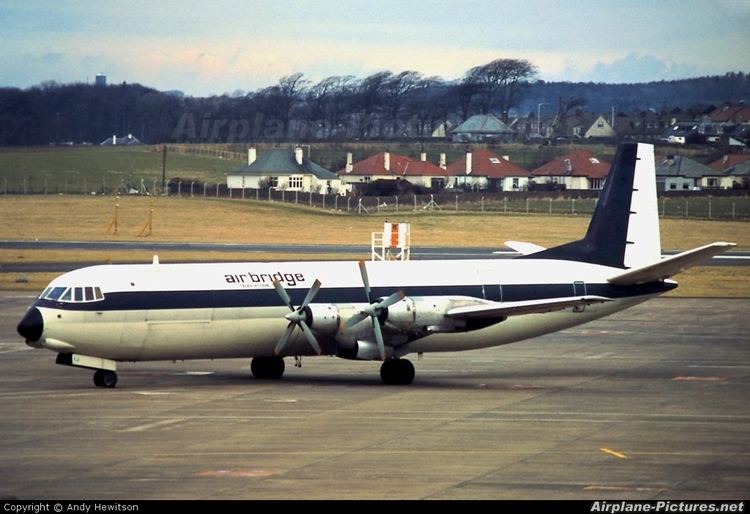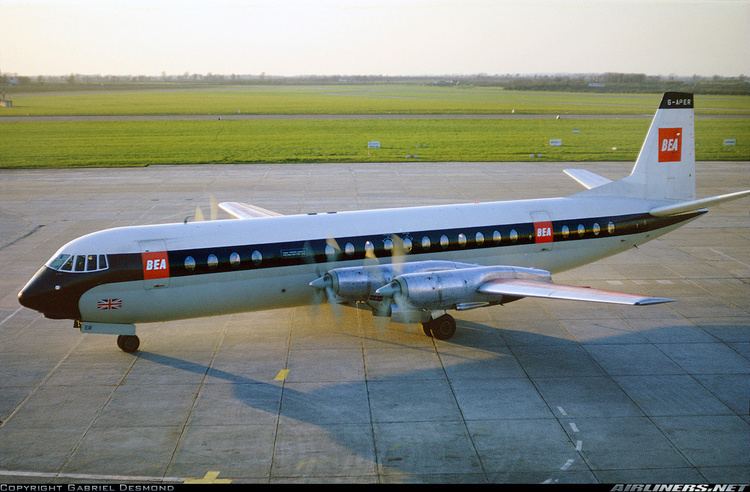Top speed 684 km/h Wingspan 36 m First flight January 20, 1959 | Length 37 m Engine type Turboprop | |
 | ||
Unit cost 67,000,000–67,000,000 USD (1957) | ||
Vickers vanguard
The Vickers Vanguard was a British short/medium-range turboprop airliner introduced in 1959 by Vickers-Armstrongs, a development of their successful Viscount design with considerably more internal room. The Vanguard was introduced just before the first of the large jet-powered airliners, and was largely ignored by the market. Only 44 were built, ordered by Trans-Canada Air Lines (TCA) and British European Airways (BEA).
Contents
- Vickers vanguard
- Awesome vickers vanguard cockpit
- Design and development
- Operational history
- Cargo operations
- Accidents and incidents
- Variants
- Operators
- Aircraft on display
- Specifications Type 952
- References

After only about 10 years service TCA experimentally converted one of theirs to a freighter configuration, calling it the Cargoliner. This was considered successful, and in the early 1970s most were converted to freighters, those from BEA becoming the Merchantman. These freighters remained in service for many years, with the last one (G-APEP) only retiring in 1996.

Awesome vickers vanguard cockpit
Design and development

The aircraft was designed to a BEA requirement for a 100-seat aircraft to replace their Viscounts. The original Type 870 design was then modified when TCA expressed their interest in the design as well, and Vickers returned the updated Type 950 that filled both requirements. The main difference between the Viscount and Vanguard was the construction of the fuselage. The Vanguard started with the original Viscount fuselage, but cut it off about halfway up from the bottom, replacing the top section with a larger-diameter fuselage to give it a double bubble cross-section (similar to the Boeing Stratocruiser). The result of the larger upper portion was a roomier interior, with increased cargo capacity below the floor.

With this larger, and heavier, fuselage came the need for a new engine to lift it. Rolls-Royce delivered their new Tyne design with a nominal 4,000 hp or 3,000 kW (compared to the Viscount's Dart of about 1,700 hp or 1,300 kW). This allowed for a much higher service ceiling and cruising speed. The Vanguard was one of the fastest turboprops ever and was faster than the present day Saab 2000 or de Havilland Canada Dash 8. A [probably hyped] pilot report describes maintaining 10,000 ft altitude with three engines feathered and the port outer at maximum cruise power; weight at start of that flight was about 112,000 lb. This is notably better performance than a Lockheed C-130, an aeroplane of similar weight and power that could not (in its introductory version of 1957) maintain a constant altitude on a single engine. Nevertheless, the Vanguard was certainly overpowered.
The first Type 950 prototype G-AOYW flew on 20 January 1959 The flight, a transfer to Wisley 3 miles away, had been planned for December but the engines were returned to Rolls-Royce for minor work. Proper flight testing was then carried out from Wisley.
Operational history
The Vanguard entered service with BEA and TCA in late 1960. BEA operated their first Vanguard schedule on 17 December from Heathrow to Paris. Following delivery of their full fleet of six V951 and 14 V953 aircraft by 30 March 1962, the type took over many of BEA's busier European and UK trunk routes. The aircraft received names of famous Royal Navy warships; the first G-APEA was named "Vanguard", however by the time that the aircraft were delivered, BEA had adopted its new "red square" livery, which saw the end of naming and none of the Vanguards actually carried a name. Initial seating was 18 first-class at the rear and 108 tourist, but this was changed to 139 all-tourist, in which configuration, the Vanguard had very low operating costs per seat/mile. On flights up to 300 mi (480 km), such as from London to Paris, Brussels and Amsterdam, the type could match the block times of the pure jets which were being introduced in the early 1960s. The remaining BEA fleet passed to British Airways on 1 April 1974 and the last BA passenger flight with the type was on 16 June 1974.
TCA initiated Vanguard schedules on 1 February 1961 with two flights from Toronto and Montreal via intermediate stops to Vancouver. The fleet was also used on services from Toronto and Montreal to New York and Nassau, Bahamas.
Cargo operations
In 1966, Air Canada removed all the seats in CF-TKK and refitted the aircraft for pure cargo work, in which role it could carry 42,000 lb (19,050 kg) of freight. Known by the airline as the "Cargoliner," it was the only such conversion, but survived to be the last Canadian Vanguard to be retired in December 1972.
BEA operated nine Vanguards modified to the V953C "Merchantman" all-cargo layout from 1969, with the first two conversions being designed and carried out by Aviation Traders Engineering Ltd (ATEL) at Southend Airport. BEA modified the remainder at Heathrow using kits from ATEL. A large forward cargo door measuring 139 by 80 inches (350 by 200 cm) was incorporated. The Merchantmen continued in service with BA until late 1979 when the remaining five were sold.
Air Bridge Carriers purchased several of the Merchantmen and operated them until 1992, when it changed to Hunting Cargo Airlines. Hunting Cargo operated their last V953C flight on 30 September 1996 and donated G-APEP to Brooklands Museum on 17 October 1996.
Accidents and incidents
Variants
Operators
These airlines operated the Vickers Vanguard:
♠ original operators
Aircraft on display
Specifications (Type 952)
General characteristics
Performance
